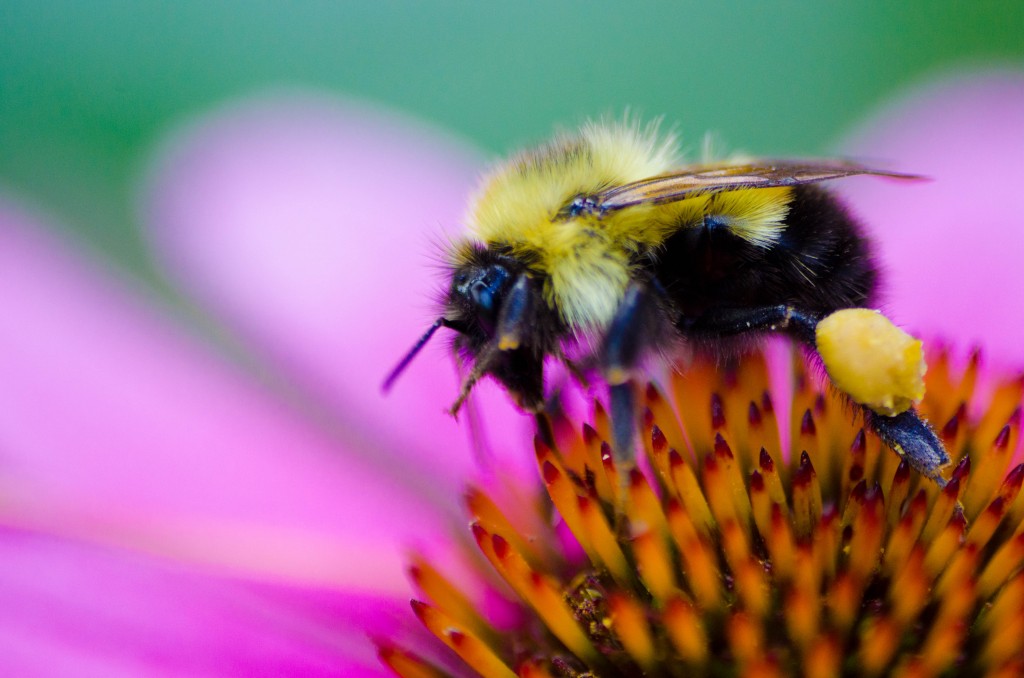20
May
White House Plan Does Little to Take the Sting Out of Pollinator Declines
(Washington, DC, May 20, 2015) Yesterday, the White House released its much awaited plan for protecting American pollinators, which identifies key threats, but falls short of recommendations submitted by Beyond Pesticides, beekeepers, and others who stress that pollinator protection begins with strong regulatory action and suspension of bee-toxic pesticides. The Pollinator Health Task Force, established by President Obama in June 2014, brought together most federal agencies to “reverse pollinator losses and help restore populations to healthy levels,” and involved developing a National Pollinator Health Strategy and a Pollinator Research Action Plan. The Strategy outlines several components, such as a focus on increased pollinator habitat, public education and outreach, and further research into a range of environmental stressors, including systemic neonicotinoid pesticides. Although well-intentioned, the Strategy ultimately works at cross-purposes by encouraging habitat, but continuing to allow pesticides that contaminate landscapes.
 “Waiting for additional research before taking action on neonicotinoid pesticides, which current science shows are highly toxic to bees, will not effectively stem pollinator declines, and is unlikely to achieve the National Pollinator Health Strategy’s goal of reducing honey bee losses to no more than 15% within 10 years,” said Jay Feldman, executive director of Beyond Pesticides.
“Waiting for additional research before taking action on neonicotinoid pesticides, which current science shows are highly toxic to bees, will not effectively stem pollinator declines, and is unlikely to achieve the National Pollinator Health Strategy’s goal of reducing honey bee losses to no more than 15% within 10 years,” said Jay Feldman, executive director of Beyond Pesticides.
A major component of the federal plan is the creation and stewardship of habitat and forage for pollinators. However, without restrictions on the use of neonicotinoids, these areas are at risk for pesticide contamination and provide no real safe-haven for bees and other pollinators. Beyond Pesticides continues to encourage federal agencies to adopt organic management practices that are inherently protective of pollinators.
Under the plan, EPA will propose prohibitions on foliar applications of bee-toxic pesticides during bloom only when a beekeeper is on-site and under contract. For all other situations, states have been tasked with creating their own pollinator protection plans that rely heavily on notification requirements and best management practices for farmers, placing an undue burden on beekeepers. The federal government’s emphasis on creating “physical and temporal space” between the use of pesticides and the presence of pollinators does little to address the chronic, sublethal threat of systemic, neonicotinoid pesticides.
“Though mitigating the effects of pesticides on bees is identified as a priority, the actions listed in the Strategy fail to address the immediate threats native and managed pollinators are experiencing from systemic chemicals that persist in soil, water, and the pollen and nectar which these critical insects feed upon,” said Mr. Feldman.
Beyond Pesticides and its allies have called for suspensions on neonicotinoid pesticides, particularly the most widely used and toxic: imidacloprid, clothianidin and thiamethoxam. These pesticides are used in a variety of home and garden products, and most commonly in corn and soybean seed treatment, where they remain in plant tissues, including pollen and nectar, for long periods of time. Along with suspensions to registrations, groups have urged EPA to conduct broader reviews on the impact of these systemic pesticides on other beneficial non-target organisms, including endangered species, and impacts to ecosystem biodiversity.
There are several factors that contribute to pollinator decline. However, it is the neonicotinoid class of pesticides that is receiving the most scrutiny from scientists and beekeepers. A growing number of studies find that even at low levels neonicotinoids impair foraging ability, navigation, learning behavior, and suppress the immune system, making bees more susceptible to pathogens and disease. A recent study finds that bees will favor neonicotinoid contaminated food over uncontaminated food, indicating that these chemicals can pose unique risks within supposedly bee-friendly habitat. In April, EPA announced a moratorium on new neonicotinoid pesticide products and uses, and its draft report on treated soybean seeds concluded that the neonicotinoid treatments were not efficacious.
The White House announcement certainly elevates the importance of pollinators and the impact their dwindling numbers will have on U.S. agriculture. One in three bites of food is reliant on pollination, which translates into $20-30 billion to the agricultural economy. But while the action taken today is well-meaning, widespread, pervasive, systemic pesticide contamination will continue to place bees, both wild and managed, and other pollinator species at risk.
Source: Whitehouse.gov
All unattributed positions and opinions in this piece are those of Beyond Pesticides.











No bees, no pollination, no pollination, no foo,d no food, no people! It’s as simple as that!
May 20th, 2015 at 7:39 pm